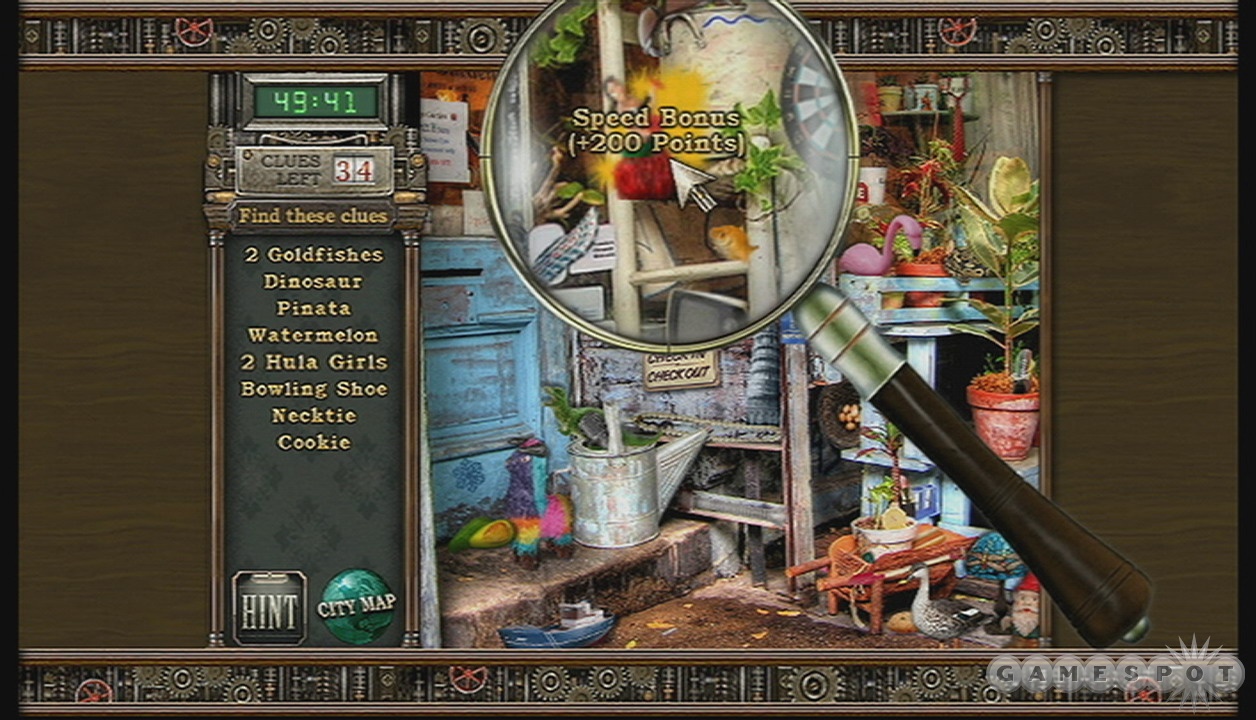In Cate West: The Vanishing Files, you play as the titular heroine who uses her mysterious psychic mojo to help the local police with a strange criminal investigation. You do this by looking at scenes that are immensely cluttered with a bizarre variety of junk and picking out a few select items; it's a hidden-object game. There are some variations on the stare-and-point gameplay, but for the most part you'll be searching, searching, remembering to blink, and then searching some more. The plot is a bland mystery that takes a good amount of time to unravel, and though recycled scenes and stingy story interludes make it feel artificially prolonged, there's still a hefty chunk of game here. With a few multiplayer options and serviceable presentation, The Vanishing Files offers adequate hidden-object fare for a reasonable price.
The plot of The Vanishing Files revolves around a series of crimes committed in the fictional city of Arcadia. They are somehow linked to the murder of Cate West's father, so the police recruit Cate to help them out. Apparently she's got some sort of extrasensory intuition. Additionally, the Three Magi are somehow involved. The whole story is appropriately convoluted, but it's hard to get caught up in it because it is told in such a sparse, halting way. The plot snippets sprinkled in-between stages are so brief that they barely have time to take hold. The illustrated character models are generic and uninteresting, though you may find yourself wondering what exactly is going on with Cate's jacket (bad fashion choice or third arm?). The real purpose of the story seems to be breaking up the long stretches of object hunting, and it does so just fine.
The actual gameplay is divided up into five different stages, each corresponding to a stage of a criminal investigation. In the first stage, you visit a number of locations around the city and search for clues. Each location presents you with a cluttered image and charges you to find items from a list. The images are generally clear enough for you to find a good number of the items, but you'll have to make use of the helpful magnifying glass for searching particularly dense areas or finding small items. If you're really stuck, you can request a hint, which will place an illuminated ring around an item's location. Getting a hint has no adverse effect on your time, though you will earn fewer points. You can boost your points by finishing quickly or finding multiple items in a row, but the only incentive to do so is your own desire for a bigger number.
The Vanishing Files does make a few stumbles in its basic gameplay, but they aren't too serious. You'll occasionally run into odd or tricky item names. When we were asked to find "After Genesis," the item on the screen ended up being the word "Exodus." Some British terms also make an entrance (American audiences won't likely know that a "plaster" is an adhesive bandage), but it's nothing that a simple hint can't solve. Visual problems pop up as well, and sometimes you'll find yourself clicking on random things that you can't identify because the items you can identify aren't on the list. This desperate, random clicking is a hallmark of the second stage: finding evidence. At this stage, Cate has identified two specific items that will help solve the case. These items are then fragmented into a bunch of pieces, and Cate has to find these pieces amid a cluttered image. Given that these pieces are merely fragments of recognizable objects, it is often quite difficult to locate them. However, in some exceptions, the fragments are clearly visible, making it all too easy to find them. These extremes are frustrating and boring, respectively.

Fortunately, the other diversions from the formula aren't as painful. Once you've found the evidence, it's off to confirm the criminal's hideout by spotting the discrepancies between two nearly identical images. This is an amusing change of pace, but it can sometimes be finicky about where exactly you click. The next stage is reminiscent of the board game Guess Who. Here, you pick the criminal out of a lineup by analyzing the various suspects' dossiers and using the clues that Cate gleans from the evidence. It's not too tough, but it is certainly easier on your eyes than object finding. The last stage is a somewhat clever inversion of the third stage that challenges you to place a bunch of items back into two nearly identical images. This takes place during a courtroom scene, and could easily be interpreted as a planting-evidence minigame. Legality aside, it's a nice way to round out the chapter. After another brief plot progression, it's on to the next chapter to do it all over again.
The Vanishing Files has 15 chapters in all, and repeating the five-stage investigation cycle 15 times takes a good amount of time. You can play the story cooperatively with another player, or compete head-to-head to earn the most points in a single stage. With only a handful of different activities, Cate West's investigations begin to feel repetitive before too long, especially when you start visiting the same locations multiple times across different chapters. The plot doesn't do much to keep things fresh because it progresses so slowly and sporadically, but it does add some welcome structure to the game. The Vanishing Files is fairly bland and has a few noticeable shortcomings, but it does offer plenty of satisfying opportunities to find hidden things at a discount price.